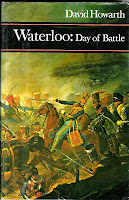
Bow your heads in honor of the 47,000 brave men who fought and perished June 18, 1815, 192 years ago today at the Battle of Waterloo: 15,000 British, Belgian, Dutch and German soldiers; 7,000 Prussians; 25,000 French. Inconceivable numbers of men lost in a battle that changed history.
 When I first decided to write Regency historicals, I immersed myself in as much of the history as I could. My library had a nice collection of audiobooks, and I used to listen to them driving to and from work. One of those books was Waterloo: Day of Battle by David Howarth (published in Great Britain under the title A Near Run Thing: The Day of Waterloo, 1968).
When I first decided to write Regency historicals, I immersed myself in as much of the history as I could. My library had a nice collection of audiobooks, and I used to listen to them driving to and from work. One of those books was Waterloo: Day of Battle by David Howarth (published in Great Britain under the title A Near Run Thing: The Day of Waterloo, 1968).
Waterloo: Day of Battle tells the story of Waterloo through the eyes of the soldiers who fought in it, making it a very personal story, very real and emotional. Howarth says the individual soldier experienced the battle “half-blinded by gunsmoke, half-deadened by noise, and either half-paralyzed by fright or driven to a kind of madness by exaltation and the hope of glory.” It is a wonderful book, available used on sites like Allbookstores.com
There are some good online sites that tell of the battle:
Waterloo for the Uninitiated – June 18th 1815
Wikipedia
or more in depth
BritishBattles.com The Battle of Waterloo
From BritishBattles.com I’ll show some highlights of the battle memorialized in paintings. You can purchase some of these prints at Art.com
 Early in the battle the British cavalry, including the Scots Greys shown here, charged the French, at first overwhelming the French, but intoxicated with their success, they advanced too far and did not hear or heed the bugles to retreat. French Cavalry, fresh in the battle, soon cut them off. The regiments were almost completely destroyed.
Early in the battle the British cavalry, including the Scots Greys shown here, charged the French, at first overwhelming the French, but intoxicated with their success, they advanced too far and did not hear or heed the bugles to retreat. French Cavalry, fresh in the battle, soon cut them off. The regiments were almost completely destroyed.

On the western side of the Allied line was the chateau and farm of Hougoumont, 3,500 men were charged with the defense of Hougoumont to protect the Allied forces from being outflanked by the French. Hougoumont was one part of the battlefield that Napoleon could see clearly and perhaps it is for that reason he poured many French resources in attempting to take it, unsuccessfully.
 French General Ney ordered his cavalry to attack what he thought were retreating Allied troops, but he found instead solid British squares, and though his cavalry attacked again and again, the squares held. The movie Waterloo , starring Rod Steiger as Napoleon; Christopher Plummer as Wellington, shows an wonderful aerial recreation of this cavalry attack.
French General Ney ordered his cavalry to attack what he thought were retreating Allied troops, but he found instead solid British squares, and though his cavalry attacked again and again, the squares held. The movie Waterloo , starring Rod Steiger as Napoleon; Christopher Plummer as Wellington, shows an wonderful aerial recreation of this cavalry attack.

In spite of the brave, heroic, and stubborn British forces, the day might have gone to Napoleon had not the Prussians under General Blücher arrived in time.
 After the battle, two square miles were covered with those 47,000 dead and dying, their shrieks and cries could be heard throughout the night as more horror assaulted them. Looters, primarily from the British and Prussian armies plundered the dead and killed the dying for their loot.
After the battle, two square miles were covered with those 47,000 dead and dying, their shrieks and cries could be heard throughout the night as more horror assaulted them. Looters, primarily from the British and Prussian armies plundered the dead and killed the dying for their loot.
 Throughout Howarth’s Waterloo: Day of Battle, he weaves a love story. Colonel Sir William De Lancey, on Wellington’s staff, had married Magdalene Hall three months earlier and she had followed him to Belgium. When word came to her that he was wounded, she searched for him and found him in a cottage near Mont St, Jean, no more than a hovel. She stayed by his side, nursing him for eleven days. At his request she lay next to him one night. The next day he died in her arms.
Throughout Howarth’s Waterloo: Day of Battle, he weaves a love story. Colonel Sir William De Lancey, on Wellington’s staff, had married Magdalene Hall three months earlier and she had followed him to Belgium. When word came to her that he was wounded, she searched for him and found him in a cottage near Mont St, Jean, no more than a hovel. She stayed by his side, nursing him for eleven days. At his request she lay next to him one night. The next day he died in her arms.
Read more about Lady de Lancey in Lady de Lancey at Waterloo by David Miller.
What are your favorite Waterloo books or websites?
There are some terrific fictional accounts of Waterloo, as well. What are your favorites?
